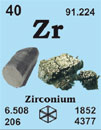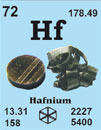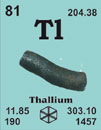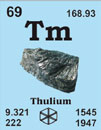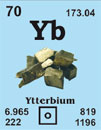Dysprosium 66Dy162.50
Discovered in 1886 by Paul-Emile Lecoq de Boisbaudran at Paris, France.
[Greek: dysprositos = hard to obtain]
French: dysprosium
German: dysprosium
Italian: disprosio
Spanish: disprosio
Description: Dysprosium is a hard, silvery metal of the so-called rare earth group (more correctly termed the lanthanides). It is oxidised by oxygen, reacts rapidly with cold water, and dissolves in acids. Dysprosium is used in alloys for making magnets.
Dysprosium single crystal properties
| State: |
Single crystal |
|---|
| Crystal structure: |
hexagonal |
|---|
| Production method: |
Floating zone |
|---|
| Standard size: |
diameter 7-8mm
thickness 1mm |
|---|
| Orientation: |
(0001) |
|---|
| Orientation accuracy: |
<2°, <1°, <0.4° or <0.1° |
|---|
| Polishing: |
as cut, one or two sides polished |
|---|
| Roughness of surface: |
<0.03 µm |
|---|
| Purity: |
99.99% |
|---|
Further Materials properties
| Crystal structure: |
(cell dimensions/pm), space group,
Orthorombic (a=359.5, b=618.3, c=567.7), Cmcm
h.c.p. (a=359.03, c=564.75), P63/mmc
b.c.c. (a=398), Im3m
T(orthorhombic -> h.c.p.) = 86 K
high pressure form: (a=334, c=245), R3m |
|---|
| X-ray diffractions mass absorption coefficients: |
CuKa 286 (µ/r) / cm2g-1
MoKa 70.6 (µ/r) / cm2g-1 |
|---|
| Neutron scattering length: |
1.69 b/10-12 cm |
|---|
| Thermal neutron capture cross-section: |
920 sa / barns |
|---|
| Density: |
8.54 kg/m-3 [293 K]; 2390 [liquid at m.p.] |
|---|
| Melting point: |
1411.85 °C / 1685 °K |
|---|
| Boiling point: |
2561.85 °C / 2835 °K |
|---|
| Molar volume: |
19.00 cm3 |
|---|
| Thermal conductivity: |
10.7 [300 K] Wm-1K-1 |
|---|
| Coefficient of linear thermal expansion: |
10.0 x 10-6 K-1 |
|---|
| Electrical resistivity: |
57.0x10-8 [293 K] Wm |
|---|
| Mass magnetic susceptibility: |
+8.00 x 10-6(s) kg-1m3 |
|---|
| Young's modulus: |
61.4 GPa |
|---|
| Rigidity modulus: |
24.7 GPa |
|---|
| Bulk modulus: |
40.5 GPa |
|---|
| Poisson's ratio: |
0.247 |
|---|
| Radi: |
Dy3+ 91; atomic 177; covalent 159 |
|---|
| Electronegativity: |
1.22 (Pauling); 1.10 (Allred); n.a. (absolute) |
|---|
| Effective nuclear charge: |
2.85 (Slater); 8.34 (Clementi); 11.49 (Froese-Fischer) |
|---|
| Number of Isotopes (incl. nuclear isomers): |
24 |
|---|
| Isotope mass range: |
147 -> 168 |
|---|
Biological data
| Biological role: |
none |
|---|
| Toxicity |
low |
|---|
| Toxic intake: |
n.a. |
|---|
| Lethal intake: |
LD50 (Chloride, oral, mouse)=7650 mg kg-1 |
|---|
| Hazards: |
Dysprosium is midly toxic by ingestion. |
|---|
| Level in humans |
|
|---|
| Blood: |
0.39 mg dm-3 |
|---|
| Organs: |
n.a. but low |
|---|
| Daily dietary intake: |
n.a. |
|---|
Total mass of element in average
[70 kg] person: |
n.a. |
|---|
Geological data
| Minerals: | Many minerals are known, and aluminium is present in many other minerals |
|---|
| Mineral | Formula | Density | Hardness | Crystal apperance |
|---|
| Bastnäsite |
(Ce, La etc.) Co3F |
4.9 |
4 - 4.5 |
hex., vit./greasy yellow |
| Monazite |
(Ce, La, Nd, Th etc.) PO4 |
5.20 |
5 - 5.5 |
mon., waxy/vit., yellow-brown |
| Chief ore: |
monazite, bastnäsite |
|---|
| World production: |
c. 100 tonnes/year |
|---|
| Main mining areas: |
USA, Brazil, India, Sri Lanka, Australia |
|---|
| Reserves: |
1.5 x 105 tonnes |
|---|
| Specimen: |
available as chips, foil, ingots or powder. Safe. |
|---|
| Abundances |
|
|---|
| Sun: |
11.5 x 106 (relative to H = 1 x 1012) |
|---|
| Earth's crust: |
6 ppm |
|---|
| Seawater: |
|
|---|
| Atlantic surface: |
8 x 10-7 ppm |
|---|
| Atlantic deep: |
9.6 x 10-7 ppm |
|---|
| Pacific surface: |
n.a. |
|---|
| Pacific deep: |
n.a. |
|---|
| Residence time: |
300 years |
|---|
| Classification: |
recycled |
|---|
| Oxidation state: |
III |
|---|
Source: Emsley, J. (1998) The Elements (3rd Edition)
Other sizes and specifications on request

 English
English
 Deutsch
Deutsch








































